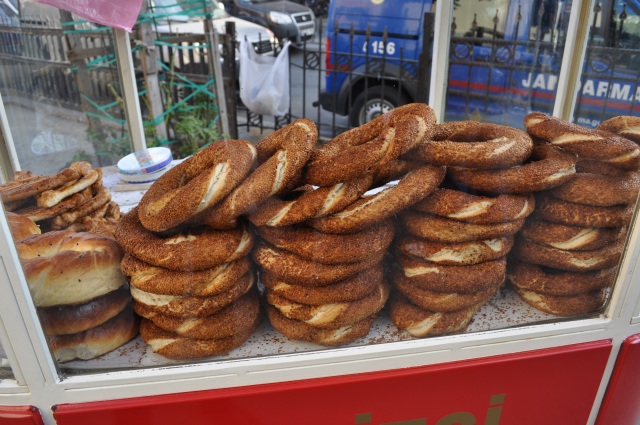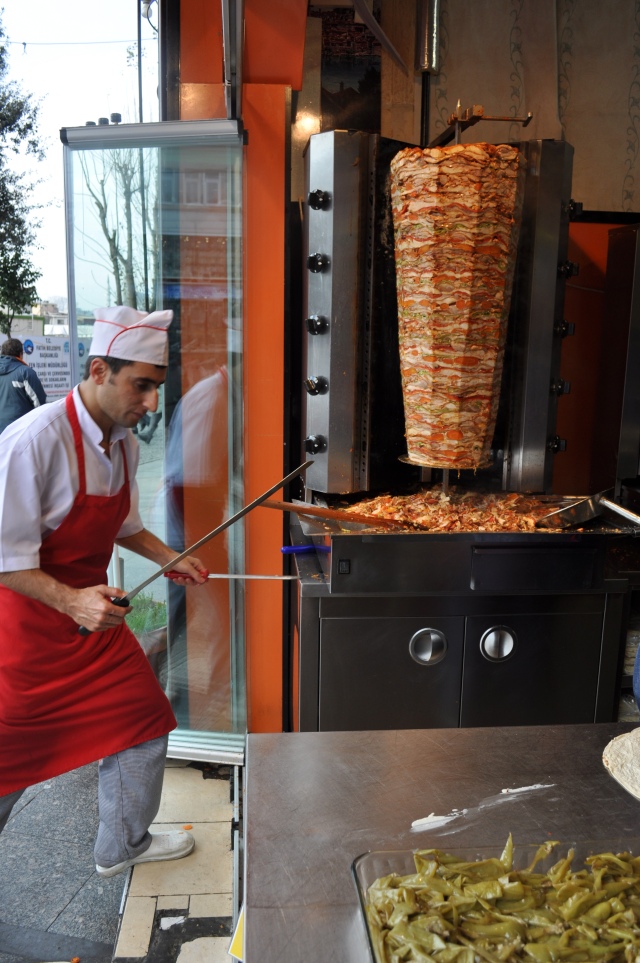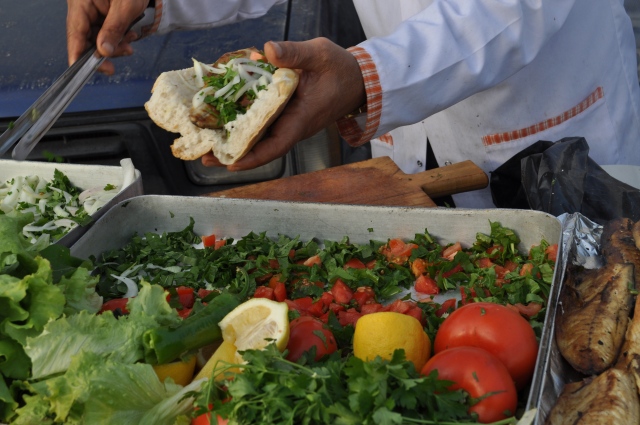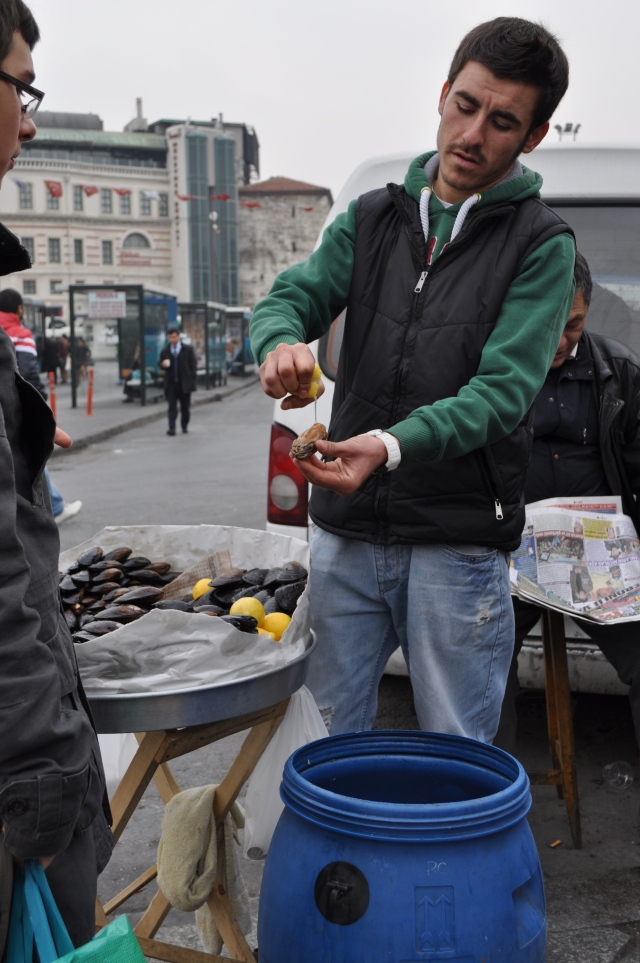As I previously mentioned, this past week I took a brief vacation from my Norwegian food venture in order to actually vacation to Istanbul. Although no longer a staycation, I made sure to try as much traditional Turkish cuisine as possible (at some points, it was mind over matter to finish that last bite of Baklava), take plenty of pictures, and learn about all the varied dishes and ingredients. From cheap and delicious street food, to basic home dishes to new and modern twists on traditional cuisine, I made sure my vacation on the Bosphorus included tasty accompaniments to all the historic mosques and steamy Turkish baths (hamams).
Street Food:
I am highly intrigued by street food. While Americans follow their twitter for the latest food truck location or may stop for a standard hot dog or New York style pretzel once in awhile, Turks live off the myriad food options that exists on the carts of the narrow streets and the banks of the Golden Horn.
 I knock the NY pretzels, but the Turks had a similar variation of a huge, salty piece of sesame bread —Simits.
I knock the NY pretzels, but the Turks had a similar variation of a huge, salty piece of sesame bread —Simits.
 Almost every other store front contained this glorious image of a massive spinning piece of meat. Döner kebabs consist of thin slices of meat (generally chicken such as the picture above or, my favorite, lamb) carved to-order from a large rotating spit. The kebabs were ridiculously cheap (about 3-4 Turkish Lire, or $2) and served in pita or half bread (fresh Italian-like bread) with toppings of tomatoes, pickles, potatoes (which was actually just random bits of french fries) and sauce. A şiş (pronounced shish) kebab consists of cubed meat and was generally available at any restaurant. My favorite şiş kebab was the patlican (pronounced pat-lee-jan), or eggplant and lamb kebab.
Almost every other store front contained this glorious image of a massive spinning piece of meat. Döner kebabs consist of thin slices of meat (generally chicken such as the picture above or, my favorite, lamb) carved to-order from a large rotating spit. The kebabs were ridiculously cheap (about 3-4 Turkish Lire, or $2) and served in pita or half bread (fresh Italian-like bread) with toppings of tomatoes, pickles, potatoes (which was actually just random bits of french fries) and sauce. A şiş (pronounced shish) kebab consists of cubed meat and was generally available at any restaurant. My favorite şiş kebab was the patlican (pronounced pat-lee-jan), or eggplant and lamb kebab.
 This picture, taken on the first day of half-conscious, jet legged exploration represents not only my first taste of Turkish cuisine but also my first “oh my God (or for Turkey, Allah) this is amazing” bite of food. Balik Ekmek translates to mean fish with bread and was sold near the Galata bridge which traverses the waters of the Golden Horn. The fish, generally a type of mackerel, is as fresh as you can get and served with mint, onion, lemon juice and sometimes tomatoes. Like the kebab, you can buy this filling lunch for roughly $2.
This picture, taken on the first day of half-conscious, jet legged exploration represents not only my first taste of Turkish cuisine but also my first “oh my God (or for Turkey, Allah) this is amazing” bite of food. Balik Ekmek translates to mean fish with bread and was sold near the Galata bridge which traverses the waters of the Golden Horn. The fish, generally a type of mackerel, is as fresh as you can get and served with mint, onion, lemon juice and sometimes tomatoes. Like the kebab, you can buy this filling lunch for roughly $2.
 If the fishy taste of mackerel from the Balik Ekmek does not require you to pop a breath mint quite yet, be sure to have some Altoids on hand after tasting street stuffed mussels. Located both near the water and intermittently throughout the city, these mussel vendors would cater to customers by opening the shells and squirting lemon juice on the mussels to be enjoyed on the spot. I went over to take a picture of the stand and was offered a free tasting. The texture of mussel and rice together makes for an interesting surprise.
If the fishy taste of mackerel from the Balik Ekmek does not require you to pop a breath mint quite yet, be sure to have some Altoids on hand after tasting street stuffed mussels. Located both near the water and intermittently throughout the city, these mussel vendors would cater to customers by opening the shells and squirting lemon juice on the mussels to be enjoyed on the spot. I went over to take a picture of the stand and was offered a free tasting. The texture of mussel and rice together makes for an interesting surprise.
 I love free samples and there were plenty to be had in Turkey, especially of the bite-sized Turkish delight treat (pictured above). In 1777, Ali Muhiddin Haci Bekir, confectioner to the Ottoman imperial court invented this chewy concoction, which he initially flavored with rosewater and sugar icing and named rahat lokum, “morsel of contentment.” In the 19th century the treat traveled westward to Britain and was aptly named Turkish delight. The treat comes in different flavor varieties and consists mainly of honey, molasses, water, flour, and nuts (walnuts, pistachios, or almonds). My favorite delights were hands down coconut with chocolate and pistachio.
I love free samples and there were plenty to be had in Turkey, especially of the bite-sized Turkish delight treat (pictured above). In 1777, Ali Muhiddin Haci Bekir, confectioner to the Ottoman imperial court invented this chewy concoction, which he initially flavored with rosewater and sugar icing and named rahat lokum, “morsel of contentment.” In the 19th century the treat traveled westward to Britain and was aptly named Turkish delight. The treat comes in different flavor varieties and consists mainly of honey, molasses, water, flour, and nuts (walnuts, pistachios, or almonds). My favorite delights were hands down coconut with chocolate and pistachio.
